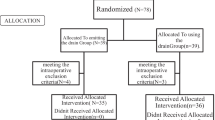Abstract
PURPOSE: The aim of the study was to assess the impact of sodium hyaluronate and carboxymethylcellulose membrane (Seprafilm®) on postoperative intestinal obstruction as judged by the rates of bowel obstruction and laparotomy for bowel obstruction. A secondary aim was to assess early postoperative morbidity. METHODS: All patients who had Seprafilm® placed during colorectal surgery between June 1993 and October 1998 were included in the study group and compared with a matched group of patients without Seprafilm®. All patients were assessed for intestinal obstruction and complications by telephone interview and chart review. Statistical tests for independence were used where appropriate; alpha was 0.05 for all tests, and the two groups were tested for case matching. Fisher's exact test was used to compare gender distribution, nature of diagnosis (inflammatoryvs. noninflammatory), and urgency of surgery (electivevs. emergency). The age distribution, number of prior abdominal surgeries, and operative time were compared by Student'st-test. Approximation of Katz test was used for independent proportions to compare the two groups for early postoperative morbidity and overall incidence of intestinal obstruction and surgical enterolysis. The incidence of intestinal obstruction between the two groups was also compared with Kaplan-Meier product limit method and log-rank test. RESULTS: Two hundred fifty-nine patients in whom Seprafilm® was placed were compared with a well-matched control cohort of 179 patients. The two groups did not differ in gender or age. One-half of each group had inflammatory conditions, and approximately 90 percent of each group underwent elective operations. The operative times were similar. Both groups had a similar number of abdominal operations before inclusion (mean = 1.2, both groups). Early morbidity rates were 17.8 percent for the Seprafilm® group and 15.6 percent for the controls, with mortality rates of 0.8 percent and 0.0 percent, respectively. There were 12 intestinal obstructions in 12 patients in the Seprafilm® group and 12 intestinal obstructions in 11 patients in the control group at a follow-up period of 65 months in the Seprafilm® group and 81 months in the control group. Eight of the 12 intestinal obstructions in the Seprafilm® group resolved with conservative management while only 5 of 12 in the control group responded without surgery. Thus the enterolysis rate was 1.5 percent in the Seprafilm® group and 3.9 percent in the control group, demonstrating a trend in favor of Seprafilm®. There were no statistically significant differences in the incidence of either overall or abdominopelvic septic complications between the Seprafilm® (3.4 percent) and control (1.1 percent) groups. CONCLUSION: During short-term follow-up in this nonprospective, nonrandomized study, limited placement of Seprafilm® did not significantly reduce the need for surgical enterolysis for intestinal obstruction or significantly adversely affect the morbidity rate. However, a long-term, prospective, randomized trial is underway to elucidate these issues.
Similar content being viewed by others
References
Menzies D. Postoperative adhesions: their treatment and relevance in clinical practice. Ann R Coll Surg Engl 1993;75:147–53.
Stewart RM, Page CP, Brender J, Schwesinger W, Eisenhut D. The incidence and risk of early postoperative small bowel obstruction: a cohort study. Am J Surg 1987;154:643–7.
Ellis H. The clinical significance of adhesions: focus on intestinal obstruction. Eur J Surg Suppl 1997;557:5–9.
Menzies D, Ellis H. Intestinal obstruction from adhesions—How big is the problem? Ann R Coll Surg Engl 1990;72:60–3.
Monk BJ, Berman ML, Montz FJ. Adhesions after extensive gynecologic surgery: clinical significance, etiology and prevention. Am J Obstet Gynecol 1994;170:1396–1403.
Scott-Coombes, Thompson JN, Vipond MN. General surgeons attitudes to the treatment and prevention of abdominal adhesions. Ann R Coll Surg Engl 1993;75:123–8.
Beck DE, Opelka FG, Bailey HR, Rauh SM, Pashos CL. Incidence of small-bowel obstruction and adhesiolysis after open colorectal and general surgery. Dis Colon Rectum 1999;42:241–8.
Ray NF, Denton WG, Thamer M, Henderson SC, Perry S. Abdominal adhesiolysis: inpatient care and expenditure in the United States in 1994. J Am Coll Surg 1998;186:1–9.
Jeekel H. Cost implications of adhesions as highlighted in a European study. Eur J Surg Suppl 1997;579:43–5.
Beck DE, Ferguson MA, Opelka FG, Fleshman JW, Gervaz P, Wexner SD. Effects of previous surgery on abdominal opening time. Dis Colon Rectum 2000;43:1749–53.
Becker JM, Dayton MT, Fazio VW,et al. Prevention of postoperative abdominal adhesions by a sodium hyaluronate-based bioresorbable membrane: a prospective, randomized, double-blind multicenter study. J Am Coll Surg 1996;183:297–306.
Moreira H, Jr. Wexner SD, Yamaguchi T,et al. Use of bioresorbable membrane (sodium hyaluronate + carboxymethylcellulose) after controlled bowel injuries in a rabbit model. Dis Colon Rectum 2000;43:182–7.
Salum M, Weiss E, Nogueras J, Wexner S. Early obstructive and septic complications with hyaluronate-based membrane in colorectal surgery [meeting abstract]. Dis Colon Rectum 1998;41:A45.
Ellis H, Moran BJ, Thompson JN,et al. Adhesion-related hospital readmissions after abdominal and pelvic surgery: a retrospective cohort study. Lancet 1999;353:1476–80.
Raf LE. Causes of abdominal adhesions in cases of intestinal obstruction. Acta Chir Scand 1969;135:73–6.
Medina H, Paddock HN, Connolly RJ, Schwaitzberg SD. Novel antiadhesion barrier does not prevent anastomotic healing in a rabbit model. J Invest Surg 1995;8:179–86.
Author information
Authors and Affiliations
Additional information
Supported by an educational grant from Genzyme Surgical Products, Inc.
About this article
Cite this article
Salum, M.R., Tzit Yuen Lam, D., Wexner, S.D. et al. Does limited placement of bioresorbable membrane of modified sodium hyaluronate and carboxymethylcellulose (Seprafilm®) have possible short-term beneficial impact?. Dis Colon Rectum 44, 706–712 (2001). https://doi.org/10.1007/BF02234571
Issue Date:
DOI: https://doi.org/10.1007/BF02234571




